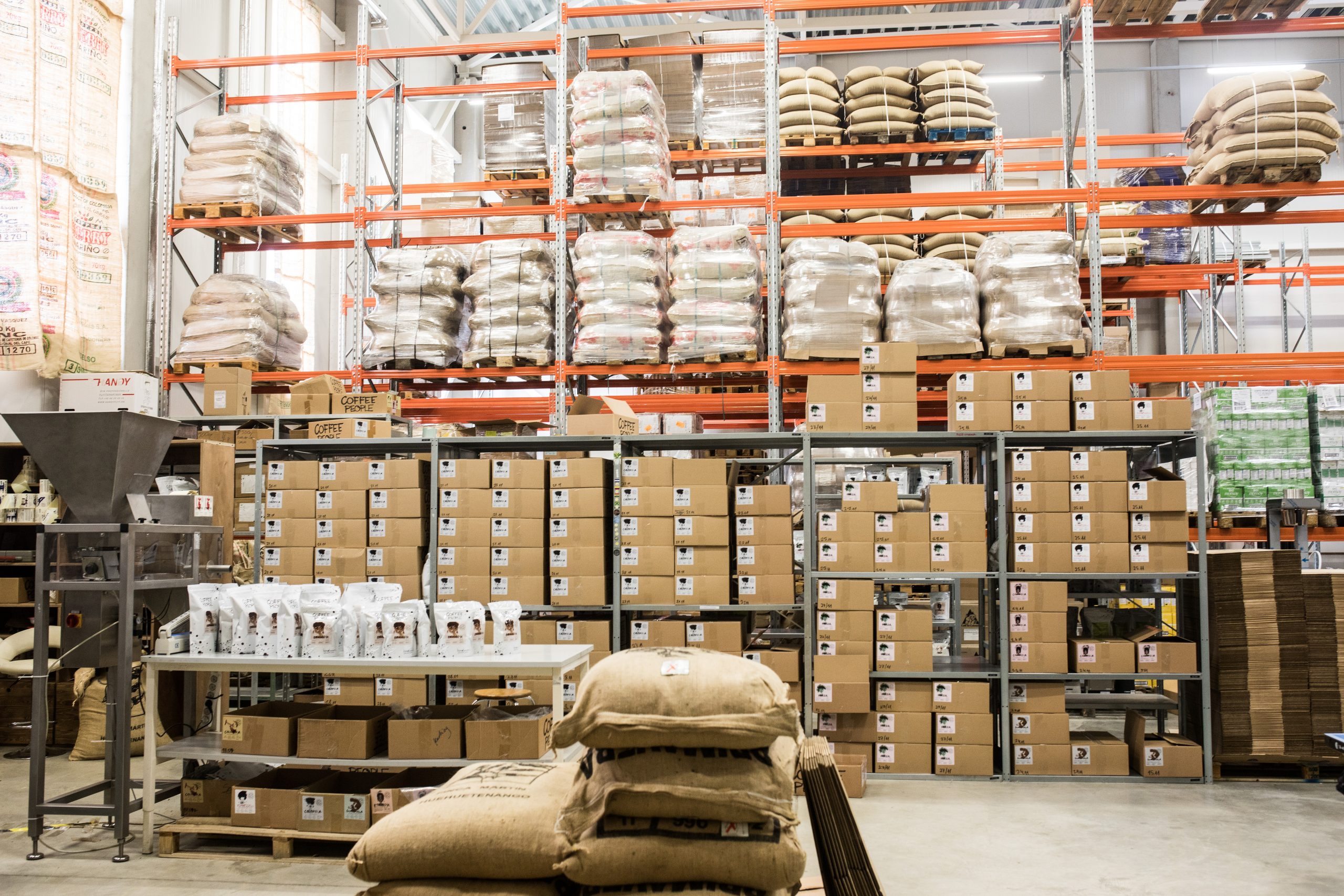Your quick guide to understanding B2B inventory management
Learn all about the core principles of B2B inventory management, as well as key strategies and technologies to optimize your supply chain and elevate your business operations.

Ioana Neamt

Typically, the concept of commerce or trade might make you think of items being shipped from businesses to regular everyday consumers, a type of trade that is also referred to as B2C. However, a significant share of commerce happens between businesses — a.k.a. business-to-business or B2B.
Let’s dive into the details of what B2B inventory is, what challenges it presents, and what benefits you can gain through employing the best management strategy and tools.
What makes B2B inventory?
There are many different elements in a supply chain that are intricately connected and dependent on each other and that require similarly complex management systems to ensure the smooth flow of goods. One such essential element of supply chains is a term that you might have met before — B2B inventory.
One example we could turn to is the manufacturing industry, where those who produce goods sell them to other manufacturers, suppliers, or wholesalers. Another layer is wholesalers selling those goods further to retailers.
Both are examples of stock being sold by one business to another, and the stock that is traded is what we refer to as B2B inventory or B2B wholesale inventory.
What does B2B inventory management mean, exactly?
The term itself seems clear enough, but let’s delve into some of the details of the process. B2B inventory management largely refers to the process of overseeing or monitoring the procurement, storage, and distribution of goods and materials that businesses sell to other businesses.
This process extends throughout all the phases of trading:
- Restocking levels — Before having the goods
- Procurement — Getting the goods
- Storage — Holding the goods
- Inventory count — Counting the goods
- Distribution — Moving the goods along through sale to other businesses or to the final consumer
B2B inventory management is an essential element of business-to-business operations, as it acts to ensure that:
- Sellers have the right products in stock to meet the needs of their customers
- The products are available in the right quantity at the right time
- That efficient restocking happens once the inventory count is down to a certain level

Is B2B wholesale inventory management different?
B2B wholesale inventory management refers to the management of stock or inventory that is distributed through a wholesale selling strategy. In very plain terms, it refers to managing stock that is sold in bulk. This does, indeed, make for some differences.
When trading inventory in large quantities, volume becomes an essential element to consider, and it requires certain stock management techniques. It matters how and where you purchase your inventory, where you stock it, how you track it across all your storage locations, and more.
There are, of course, several software solutions available that can make all of the steps a lot easier for you to control. But which one is the right fit for you? Read through the tips on wholesale inventory management post to pick the perfect wholesale inventory software for your needs and optimize your business operations with ease.
10 main challenges of B2B inventory management
Due to the complex nature of business-to-business trade relationships and the generally high value of goods that are exchanged, B2B inventory management does present a unique set of challenges.
1. Complex supply chains
B2B supply chains generally involve a combination of several intermediaries and suppliers, which can make it difficult to deliver products in a timely manner. If not managed appropriately, this complexity can lead to stockouts, backorders, and increased costs for your business.
2. Inventory cost challenges
The goods that make up B2B inventory are typically more expensive than B2C goods. This means that if you are carrying too much inventory, you are tying up more capital than is necessary for overstocked items while also being challenged by higher storage costs to accommodate the surplus.
3. Variability of demand
Demand in business-to-business trade can be more volatile than in business-to-consumer distribution. This makes it more difficult to anticipate demand accurately. The challenge of variability in demand can lead to both stockouts and excess inventory.
4. Sales cycles duration
Another difference between B2C and B2B is sales cycles, which tend to be longer in the case of distribution between businesses. This creates the challenge of businesses needing to manage inventory over a longer period of time, which can add to the difficulty of accurately predicting demand and planning production.
5. Complex ordering patterns
Business-to-business companies also often must handle a high volume of purchase orders from multiple customers that require a variety of delivery schedules, different quantities, and various lead times. This complexity also adds to the difficulty of forecasting and restocking.
6. Managing customer expectations
Regardless of whether the customer is a person or a business, it is important to operate with the understanding that the customer’s expectation is important. The quality of your performance will often be weighed based on product availability and delivery times, and meeting these expectations can be challenging when dealing with complex supply chains and variable demand.
7. Inaccurate data challenges
Running a distribution operation based on inaccurate or incomplete inventory data can lead to several issues, including stockouts, overselling, and incorrect order fulfillment.
8. Limitations of inventory visibility
If your inventory is hard to identify or locate in any of your storage locations, you are likely to find yourself dealing with incomplete, inaccurate, or delayed shipments. Making sure that you receive and locate the right stock is very important in efficient warehouse operations and in creating positive customer experiences.
9. Management systems integration
One of your administrative challenges will have to do with having multiple software solutions for managing different aspects of your business. For best results, your inventory management systems should integrate with other enterprise systems, which can be a complex and time-consuming challenge.
10. Keeping technology current
Much like your inventory, technology moves fast. And, much like with inventory, using the most current technology matters to the quality of your distribution. Inventory management technology is constantly evolving, and staying up to date with new technologies and best practices can be challenging but is a necessary part of staying competitive.

10 key benefits of B2B inventory management software
Employing the right B2B inventory management software can go a long way toward overcoming the inherent challenges of the business and can help you enjoy a number of benefits.
1. Improve the accuracy of inventory data
Using inventory management software eliminates manual tracking of stock levels, which eliminates your risk of human error affecting data accuracy.
2. Track inventory in real-time
B2B inventory management software allows you to have real-time visibility into inventory levels across multiple locations. Having real-time data ensures you are appropriately aware of your stock levels at all times, so you are well-positioned to avoid stockouts and/or overstocks.
3. Automate reordering and replenishment
With inventory management software, you can automate the reordering and replenishment processes based on your tracking of predetermined reorder points and safety stock levels. This also reduces your risk of stockouts or overselling.
4. Enhance demand forecasting
Analyze historical sales data and trends to better forecast future demand, which will help refine your decisions about inventory levels and production schedules.
5. Optimize warehouse operations
Inventory management software can help you optimize warehouse operations by providing you with efficient stock-picking and put-away processes and reducing the time and effort needed to locate and manage your goods.
6. Streamline order fulfillment
Real-time inventory visibility enables your business to fulfill orders more accurately and efficiently, which will, in turn, position you to meet customer expectations and improve overall customer satisfaction.
7. Reduce inventory costs
With automated inventory management software, you can streamline many processes and optimize inventory levels, which will reduce carrying costs and storage expenses.
8. Improve decision-making
The insights and data you gain through inventory management software empower you to make better decisions regarding your management strategies, purchasing, and production planning.
9. Enhance collaboration with suppliers
The right B2B inventory management software for your business can facilitate real-time communication and collaboration with suppliers, as well as enable better planning and coordination.
10. Improve scalability
As your business grows, your inventory management software should scale to accommodate aspects like increased volumes, a larger number of storage locations, and new product lines while providing consistent and effective management.
There are various B2B inventory management strategies that your businesses can turn to. The best one for you will depend on such things as the type of products in your inventory, the length of the sales cycle, and the risk tolerance of your business. By understanding what each challenge refers to and what can best resolve them, you can perfect your process and meet your inventory management needs efficiently.
Streamline your B2B inventory management with Katana
With Katana as your inventory management software partner, you’ll be able to beat the challenges of B2B inventory management and streamline your manufacturing operations. From real-time inventory management, multilocation support, and end-to-end traceability to multichannel inventory solutions and product availability tracking, Katana offers solutions to help you optimize workflows and avoid the pitfalls of inaccurate inventory management.
If you wish to see Katana in action, just click here to book a demo and talk to our sales team.

Ioana Neamt
Table of contents
Get inventory trends, news, and tips every month
Get visibility over your sales and stock
Wave goodbye to uncertainty by using Katana Cloud Inventory for total inventory control
